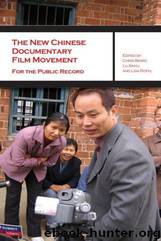The New Chinese Documentary Film Movement - For the Public Record by Rofel Lisa & Xinyu Lu & Berry Chris

Author:Rofel, Lisa & Xinyu , Lu & Berry, Chris [Rofel, Lisa]
Language: eng
Format: mobi
Publisher: Hong Kong University Press
Published: 2010-09-30T16:00:00+00:00
In the final stages of the film, this struggle of the posters and banners extends to encompass film and photography. We see one of Zhang’s holdout neighbors not only putting up protest posters on her house before it is pulled down, but also taking pictures of the posters. In the final demolition of Zhang’s house, not only are Ou and his colleagues recording the process, but at least two representatives from the police and the local authorities are also recording it. When the house comes down, Zhang has his camera as well. But he is too upset to record, and as Ou and his colleagues film Zhang’s tears, the screen goes to black, and the noise of the demolition crashes over the closing credits. This ending communicates very clearly the reticence of Ou and his colleagues and their formal difference from mainstream documentary, as they continue to make no comment. But it also dramatizes the official and alternative archiving processes themselves. We see the police and the authorities focus their cameras on their own procedures, filming the reading out of the order to demolish to Zhang so that they have a record to show that they have done the right thing. Meanwhile, Ou and his colleagues are more concerned with Zhang’s reactions and feelings, which would otherwise remain unrecorded because they are of no interest to the official archive.
The formal innovation of turning the subjects of the documentary into documentarians themselves is by no means confined to Meishi Street, but is in fact one of the main characteristics of the New Documentary Movement, especially after the arrival of the DV camera. As Yiman Wang has discussed, this relatively easy-to-use technology is closely tied to the conscious espousal of an amateur aesthetic in Chinese documentary and the involvement of growing numbers of professionals outside the media industries in the movement.17 Another excellent example of this amateur aesthetic is Zheng Dasheng’s DV China (2003). This documentary follows a citizen of Jingdazhen who buys a video camera and mobilizes his fellow residents to make dramatic videos — which he calls “TV series” — in a variety of popular genre forms ranging from martial arts to revolutionary dramas. Other examples include Hu Xinyu’s The Man (2003) and Zuo Yixiao’s Losing (2005), discussed in detail in Luke Robinson’s chapter in this volume.
Download
This site does not store any files on its server. We only index and link to content provided by other sites. Please contact the content providers to delete copyright contents if any and email us, we'll remove relevant links or contents immediately.
| Anthropology | Archaeology |
| Philosophy | Politics & Government |
| Social Sciences | Sociology |
| Women's Studies |
Cecilia; Or, Memoirs of an Heiress — Volume 1 by Fanny Burney(32413)
Cecilia; Or, Memoirs of an Heiress — Volume 3 by Fanny Burney(31824)
Cecilia; Or, Memoirs of an Heiress — Volume 2 by Fanny Burney(31807)
The Great Music City by Andrea Baker(31251)
We're Going to Need More Wine by Gabrielle Union(18951)
All the Missing Girls by Megan Miranda(15497)
Pimp by Iceberg Slim(14321)
Bombshells: Glamour Girls of a Lifetime by Sullivan Steve(13952)
Talking to Strangers by Malcolm Gladwell(13185)
Norse Mythology by Gaiman Neil(13171)
Fifty Shades Freed by E L James(13145)
For the Love of Europe by Rick Steves(12658)
Mindhunter: Inside the FBI's Elite Serial Crime Unit by John E. Douglas & Mark Olshaker(9164)
Crazy Rich Asians by Kevin Kwan(9147)
The Lost Art of Listening by Michael P. Nichols(7388)
Enlightenment Now: The Case for Reason, Science, Humanism, and Progress by Steven Pinker(7168)
The Four Agreements by Don Miguel Ruiz(6599)
Bad Blood by John Carreyrou(6520)
Weapons of Math Destruction by Cathy O'Neil(6116)
